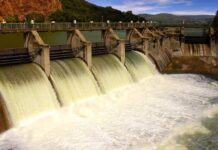The world’s largest power-producing tidal barrage revitalized an unsuccessful manmade reservoir that was once known as “The Lake of Death.”
From space, the 12.7-kilometer (km) Sihwa Lake tidal barrage that houses a 400-meter (m)-long tidal power plant looks like a delicate strand stretched across one of many bays and inlets characterizing the craggy coastline of Gyeonggi Bay in the Korean Peninsula’s northwestern region. On site, however, there is no question that the 254-MW tidal power plant designed to reap energy from the highest tides in the vast Yellow Sea is a marvel of engineering.
That’s why it’s curious that the $355 million tidal power plant—the first of its kind in South Korea, and the largest in the world since construction of France’s 240-MW La Rance tidal power plant in 1965—was conceived as an afterthought.
In 1994, South Korea created the 56.5-square-kilometer (km2) freshwater Lake Sihwa by constructing a 12.7-km dike between Oido Island in Siheung city and Daebudo Island in Ansan city to secure agricultural and irrigation water, and to reclaim 173 km2 of land near the local metropolitan areas of three cities surrounding the lake.
But within years after the embankment was built, it was apparent that without seawater circulation, Lake Sihwa—which is about the size of Manhattan Island—was seeing an inordinate inflow of polluted wastewater from a nearby industrial complex. The pollution severely contaminated the basin and made it unusable as a freshwater reservoir, as intended. By 1997, partly driven by a pollution scandal that dubbed Sihwa “The Lake of Death,” officials were forced to reformulate their plans, opening a sluice to allow seawater to regularly flush the basin.
PWR_120115_TP_LakeSihwa_PowerPoints
That move prompted South Korean governmental water authority Korea Water Resources Corp. (then KOWACO, and recently renamed K-water) to step in and propose a tidal power barrage that uses a single-effect flood generation method and allows up to 60 billion tons of seawater to be circulated annually.
By December 2002, the project was approved, and precisely two years later, in 2004, construction began. Seven years after that, in December 2011, K-water’s Sihwa Lake tidal power plant was connected to the grid, equipped with 10 bulb-type generator units (each 25.4 MW) that produce about 552.7 GWh annually.











































